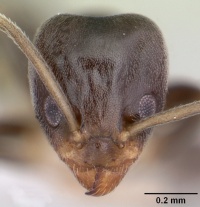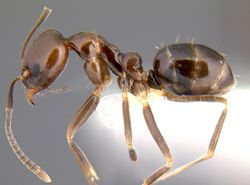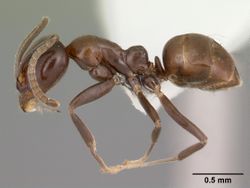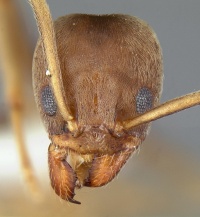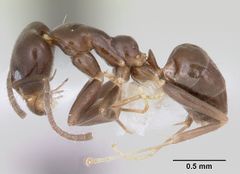Key to Linepithema workers
This worker key is based on: Wild, A. L. 2007a. Taxonomic revision of the ant genus Linepithema (Hymenoptera: Formicidae). University of California Publications in Entomology. 126:1-159.
You may also be interested in
1
- Metapleuron anterior of metapleural gland orifice with a central area devoid of pubescence; if some appressed hairs present, then distance between hairs is greater than length of hairs; those specimens ambiguous or intermediate in this character should key out through both couplets . . . . . 2
- Metapleuron anterior of metapleural gland orifice with many appressed hairs on surface, distance between hairs less than length of hairs, hairs often densely spaced but sometimes fading to sparse ventrally; those specimens ambiguous or intermediate in this character should key out through both couplets . . . . . 16
2
return to couplet #1
- Antennal scapes short (SI < 86), in full face view scapes in repose do not surpass posterior margin; eyes small, with fewer than 40 ommatidia; body color pale yellow to light brown, never medium brown to black . . . . . 3
- Antennal scapes longer (SI > 87), in full face view scapes in repose surpass posterior margin; eye size variable, usually with more than 40 ommatidia (35–50 in L. fuscum); body color variable . . . . . 4
3
return to couplet #2
- Eyes with < 25 ommatidia; antennal scapes very short, SL < 0.45; frontal carinae relatively widely spaced, CDI > 30; petiolar scale in lateral view relatively tall, exceeding level of propodeal spiracle; propodeum only slightly depressed below level of promesonotum; Paraguay . . . . . Linepithema cryptobioticum
- Eyes with > 25 ommatidia; antennal scapes longer, SL > 0.50; frontal carinae relatively narrowly spaced, CDI < 29; petiolar scale in lateral view not exceeding level of propodeal spiracle; propodeum depressed well below level of promesonotum; Hispaniola . . . . . Linepithema flavescens
4
return to couplet #2
- Head and mesosoma dorso-ventrally flattened; propodeal spiracles produced into prominent posterolateral corners of the propodeum; petiolar node low and blunt; Brazil and Paraguay . . . . . Linepithema aztecoides
- Head and mesosoma not dorso-ventrally flattened; propodeal spiracles not prominent; petiolar node not low, produced instead as an anteriorly-inclined scale . . . . . 5
5
return to couplet #4
- Mesonotum slender with a strong, step-like medial impression; cephalic dorsum in undamaged specimens with more than 5 standing setae; Central America and the Caribbean to southern Brazil . . . . . Linepithema iniquum
- Mesonotum more robust, usually without a strong, step-like medial impression; if medial impression present (some populations of L. dispertitum and L. angulatum), then cephalic dorsum with fewer than 5 standing setae; setae on cephalic dorsum otherwise variable . . . . . 6
6
return to couplet #5
- With the following combination of character states: propodeum in lateral view relatively low, with posterior face distinctly shorter than dorsal face; metanotal groove weakly or not at all impressed; metapleuron with at least a few scattered appressed setae anterior of metapleural gland opening . . . . . 24
- Either propodeum in lateral view with posterior face longer than or subequal in length to dorsal face; or with mesonotal groove moderately to strongly impressed; or with metapleuron completely devoid of appressed setae anterior of metapleural gland opening . . . . . 7
7
return to couplet #6
- Pronotum lacking erect setae; body color medium brown to piceous; Mexico to Costa Rica and Hispaniola . . . . . Linepithema dispertitum (in part - also #8, #23)
- Pronotum bearing erect setae (may be missing in damaged specimens); color variable . . . . . 8
8
return to couplet #7
- Mexico; color medium brown to piceous . . . . . Linepithema dispertitum (in part - also #7, #23)
- South America, the Caribbean, and Central America south of Mexico; color variable . . . . . 9
9
return to couplet #8
- Sculpture on dorsum of head superficial, limited to small punctures associated with pubescence, surface shining through pubescence; head immediately laterad of eyes with pubescence sparse; head and body relatively robust (CI > 92); gastric tergite 1 with > 10 erect to subdecumbent setae; Hispaniola . . . . . Linepithema keiteli
- Sculpture on dorsum of head densely and finely punctate/pubescent, surface appearing dull or opaque; head immediately laterad of eyes with pubescence moderate to dense; habitus variable; pilosity variable; Central and South American mainland . . . . . 10
10
return to couplet #9
- Pubescence moderate to sparse on gastric tergites 3–4 (= abdominal tergites 5–6); mesonotum relatively angular; metanotal groove usually deeply impressed; small species (HL < 0.65); body color testaceous to reddish-brown; Atlantic forest regions of Brazil, Paraguay and Argentina . . . . . Linepithema pulex
- Pubescence dense on gastric tergites 3–4; other characters variable; Costa Rica south to the Pantanal . . . . . 11
11
return to couplet #10
- Cephalic dorsum bearing standing setae near vertex . . . . . 12
- Cephalic dorsum lacking standing setae near vertex . . . . . 15
12
return to couplet #11
- Central America . . . . . 13
- South America . . . . . 14
13
return to couplet #12
- Antennal scapes longer, SI > 99, in full face view scapes in repose surpass posterior margin by a length greater than or equal to that of first funicular segment . . . . . Linepithema piliferum (in part - also #14)
- Antennal scapes shorter, SI < 97, in full face view scapes in repose surpass posterior margin by a length less than that of first funicular segment . . . . . Linepithema angulatum (in part - also #15)
14
return to couplet #12
- Head in full face view with posterior margin deeply concave; head usually reaching widest point near level of compound eyes; antennal scapes relatively short (SI < 97), in full face view scapes in repose surpass posterior margin by a length less than length of first funicular segment; Ecuador and Colombia . . . . . Linepithema tsachila (in part - also #21)
- Head in full face view with posterior margin straight or only slightly concave; head usually reaching widest point posterior of compound eyes; antennal scapes relatively long (SI < 99), in full face view scapes in repose surpass posterior margin by a length greater than or equal to length of first funicular segment; northwestern South America to Costa Rica . . . . . Linepithema piliferum (in part - also #13)
15
return to couplet #11
- Head width < 0.53; eyes relatively small, with 35–50 ommatidia; metanotal groove not impressed or only weakly impressed; body color medium to dark brown, never testaceous; Andean South America . . . . . Linepithema fuscum
- Head width > 0.53; eyes of moderate size, with 45–70 ommatidia; metanotal groove usually strongly impressed; body color testaceous to medium brown; Costa Rica to southern Brazil . . . . . Linepithema angulatum (in part - also #13)
16
return to couplet #1
- Mesopleural pubescence dense throughout . . . . . 17
- Mesopleural pubescence fading to moderate, sparse, or absent anteroventrally . . . . . 20
17
return to couplet #16
- Pubescence on gastric tergites 2–4 (= abdominal tergites 4–6) moderate to sparse on most specimens in a series, gastric dorsum strongly shining; elongate ants with long antennal scapes (SI 120–139); Andean Bolivia and Argentina . . . . . Linepithema oblongum
- Pubescence dense on all gastric tergites; antennal scape length variable but SI never exceeding 130 . . . . . 18
18
return to couplet #17
- With the following combination of characters: pronotum lacking standing setae; 1st and usually 2nd gastric tergite (= abdominal tergite 4) lacking standing setae; eyes relatively large, with more than 80 ommatidia, OI > 30; cosmopolitan . . . . . Linepithema humile
- Without the preceding combination of characters: 2nd gastric tergite bearing standing setae; pronotal setae present or absent; eye size variable . . . . . 19
19
return to couplet #18
- Antennal scapes long (SI 119–126); head in full face view narrow (CI 80–85); pronotum lacking standing setae; Brazil . . . . . Linepithema anathema
- Antennal scapes of moderate length (SI 97–110); head in full face view moderate to broad (CI 84–95); pronotum with setae present or absent; Argentina, Paraguay, and Brazil . . . . . Linepithema micans
20
return to couplet #16
- Strikingly bicolored, head dark brown and contrasting with pale whitish yellow on all or part of the mesosoma and appendages; antennal scapes long (SI 106–125); southeastern Brazil . . . . . Linepithema leucomelas
- Coloration not as above; if bicolored, contrast is between shades of light reddish brown and dark brown; scape length variable . . . . . 21
21
return to couplet #20
- Pronotum relatively pilose, bearing 2–8 standing setae of varying length, the longest seta noticeably exceeds the length of the compound eye; head in full face view with posterior margin deeply concave; antennal scapes relatively short (SI < 97), in full face view scapes in repose surpass posterior margin by a length less than that of first funicular segment; Ecuador and Colombia . . . . . Linepithema tsachila (in part - also #14)
- Pronotum with standing setae noticeably shorter than length of the compound eye or absent; head shape variable; antennal scape length variable . . . . . 22
22
return to couplet #21
- Maxillary palps shorter than ½ head length, palps when fully extended along cephalic venter do not exceed level of posterior extension of compound eye; posterior margin of propodeum in profile relatively straight above the level of propodeal spiracle and inclined anteriorly, meeting dorsal face at an angle; mesonotal dorsum usually angular with distinct long dorsal and short posterior faces; antennal scapes in repose exceeding posterior margin of head by a length less than or subequal to that of first funicular segment (SI 89–107, usually < 100); Argentina to Venezuela . . . . . Linepithema gallardoi
- Maxillary palps longer than ½ head length, palps at full extension along cephalic venter exceed level of posterior extension of compound eye; other characters variable . . . . . 23
23
return to couplet #22
- Propodeum in lateral view with posterior face longer than or subequal in length to dorsal face; mesonotal groove usually moderately to strongly impressed; body size larger (HL > 0.70); color dark brown to piceous; Mexico, Central America and Hispaniola . . . . . Linepithema dispertitum (in part - also #7) (in part - also #8)
- Propodeum in lateral view with posterior face distinctly shorter than dorsal face; mesonotal groove weakly or not at all impressed; body size smaller (HL < 0.70); color variable; Costa Rica to southern Brazil . . . . . 24
24
return to couplet #6 return to couplet #23
- Mesosoma in profile with propodeum depressed only slightly below level of mesonotum; antennal scapes relatively short (SL 0.44–0.54), in repose surpassing posterior margin of the head by a length less than that of the first funicular segment; body color testaceous to medium brown, never dark brown or piceous; Bolivia and Paraguay to eastern Brazil . . . . . Linepithema cerradense
- Mesosoma in profile with propodeum depressed well below level of mesonotum; antennal scapes somewhat longer (SL 0.50–0.64), surpassing posterior margin of the head by a length subequal to that of the first funicular segment; body color variable, often dark brown; Costa Rica to southern Brazil . . . . . Linepithema neotropicum




